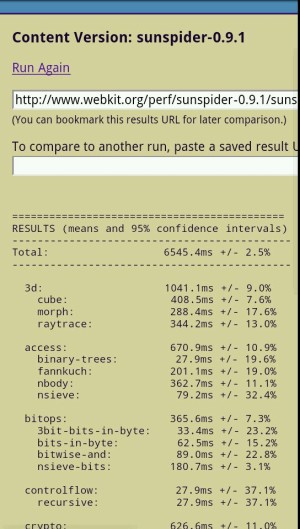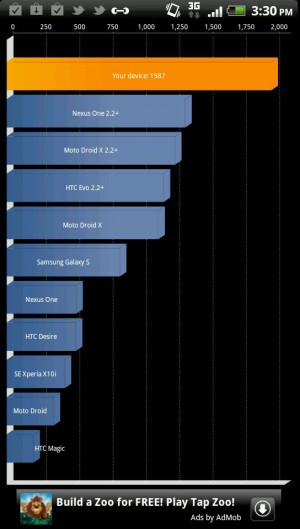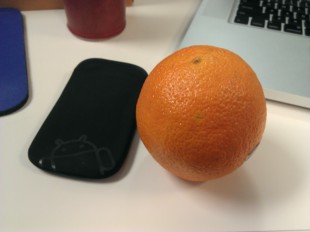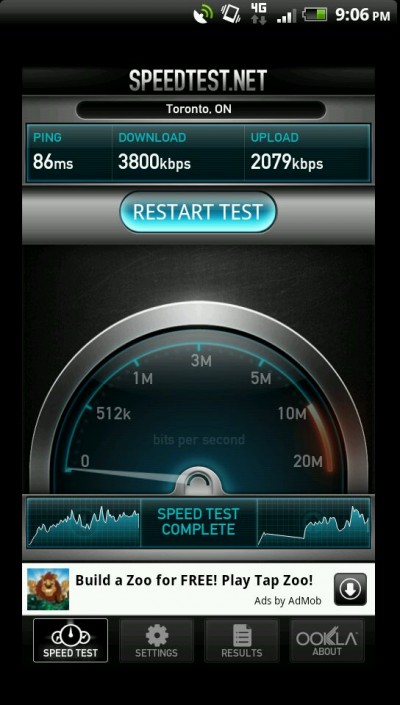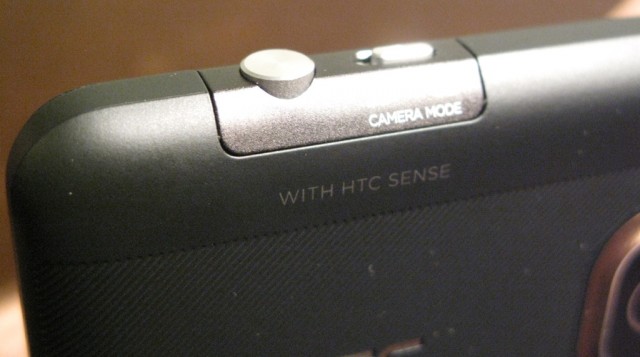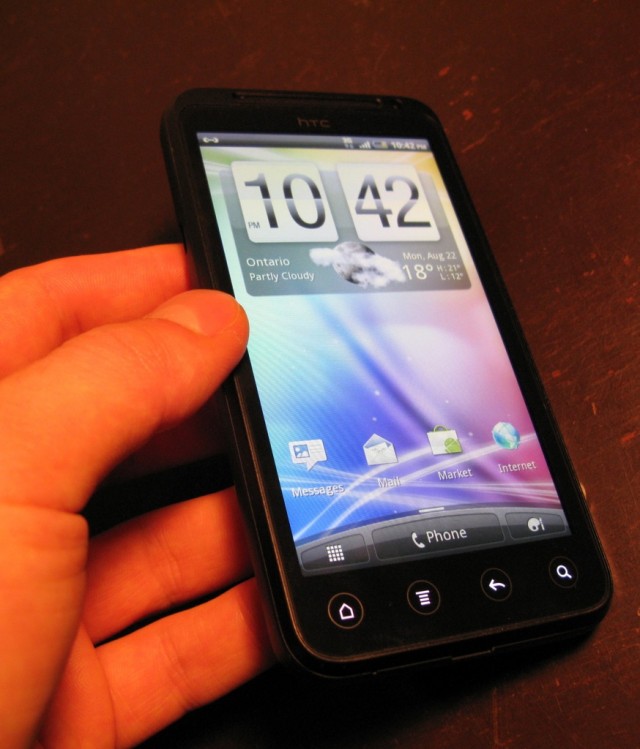
At some point you just have to accept that 3D is here to stay. The notional concept is sound: two images, transposed and adjusted so that the left eye views one, and the right the other. Together the brain is tricked into thinking it is 3D. It’s a simple conceit made rigidly commercial.
How it will eventually interact with the phone market over the long term is yet to be seen, however. HTC and some of its competitors in the Android space, most notably LG, have made a push for 3D, and Rogers has picked up two flagship devices in the space: the LG Optimus 3D, which we looked at earlier, and the EVO 3D, which comes to us from an initial launch on Sprint in June.
More than just a 3D-enabled Android device, it’s an attractive dual-core unit with a high-resolution qHD screen and 1GB of RAM. Is this the Android device to get in a very crowded market? Read on to find out.
Specs:
– Android 2.3.4 with HTC Sense 3.0
– 4.3” 960×540 pixel 3D-capable display
– 1.2Ghz dual-core Qualcomm Snapdragon MSM8260 Soc
– 1GB RAM / 1GB application storage (8GB microSD card included)
– 2x5MP cameras with LED flash and dedicated shutter button, 1.3MP front camera
– 720p-capable 2D and 3D video capabilities
– WiFi (b,g,n) / A-GPS / Bluetooth 3.0 with A2DP support
– MHL-out for HDMI playback (requires adapter, sold separately)
– 126 x 65 x 12.1 mm
– 170g
– HSDPA 14.4Mbps, HSUPA 5.76Mbps
– 850/900/1800/1900Mhz (2G), 850/1900Mhz (3G)
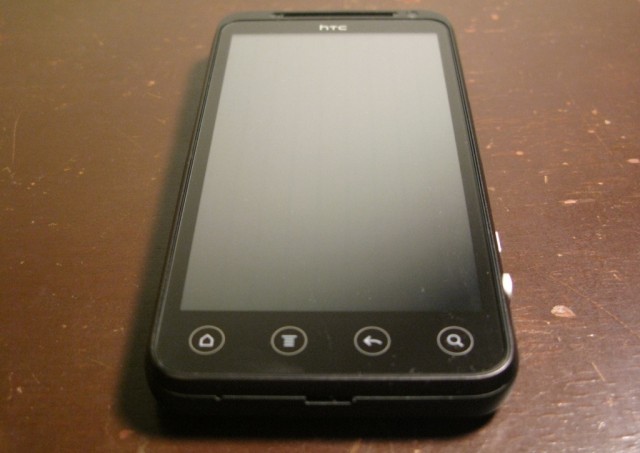
The Phone
EVO. To us Canadians it means very little, but in the US it introduced the first 4G Android device on Sprint. Since its debut in June 2010 it has consistently been one of the top-selling devices, despite its sheer size and limited battery life. It has also spawned some worthy progeny, and Rogers arguably gets the best EVO to date.
The EVO 3D is bulky. That’s not to say it feels excessively large, but it’s definitely a pocket squeezer. Despite that fact, it also fits better in the hand than most traditional Android devices due to its 16:9 aspect ratio, making it slightly thinner horizontally and longer vertically. The screen resolution is higher, too, at 960×540 pixels, and it seems that the LCD itself is the same as one found in the Sensation.
The device is well-built, with a heft to it usually reserved for a hardware keyboard, but its lithe 12.1mm girth manages to excuse the 170g weight. While it does not have the same premium aluminum design as the Sensation, from front to back the EVO is an exceptionally well-made. The face is graphite-coloured aluminum, while the battery cover, which wraps around the device securely, is a thick plastic mould. Because it adheres to the body along the sides there is no creakiness, and it allows more easily for holes to be cut for the dual camera assembly. Certainly compared to the Sensation, which is entirely aluminum, the EVO fares slightly worse, but is still miles ahead of the competition.
Of course when you factor in the dual cameras, it’s apparent there is an emphasis on media capture, and in that sense the EVO doesn’t disappoint. There is a dedicated shutter button — a gorgeous drilled piece of aluminum – that sits flush on the right of the device, near the bottom. To its immediate left is a switch that easily shifts between 2D and 3D modes in the Camera app.
The back of the device is dominated by the cameras, and though it looks somewhat like a pair of robot eyes with a dual-LED nose surrounded by a golden sheath, there is a austerity to its form that belies its sophistication. To further its function is a diagonal ribbed texture that makes the EVO 3D easy to grip, and delightful to hold.

The Display
Like the Sensation, the EVO 3D employs a qHD Super LCD display. The extra resolution is appreciated, especially when reading web pages, since text is remarkably sharp and contrast levels are excellent.
We had issues with the screen washing out at very narrow angles, and with black levels looking somewhat gray, but for the most part the more we used the device the less these issues bothered us. What we noticed was the excellent colour saturation, fantastic brightness and smooth gradients; no banding on this 24-bit screen.
When switched the 3D mode, applicable only to specifically-supported applications (most of which are bundled with the phone) the quality is a little bit more fuzzy: yes, there is a notable resolution drop, but brightness, colour quality and black levels all degrade too. With the tech in its infancy, the scenario will only improve in time, but watching a movie clip for more than a couple minutes in three dimensions was tiring on the eyes. Because of a narrow ideal viewing angle when we adjusted the phone even slightly it adversely affected the picture quality.
Still, seeing your photos or video in 3D is a stunning and at times awesome experience.
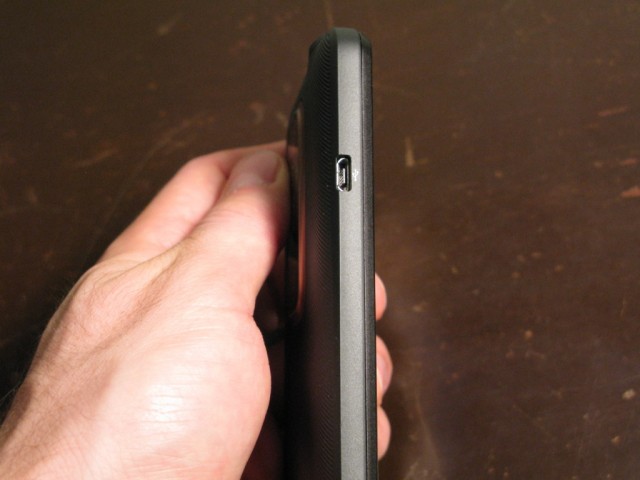
Sense 3.0D
We complained about the performance of the Sensation, which runs the same version of Android, and the same version of Sense UI, as the EVO 3D. Somehow the engineers at HTC in their brief time between releasing the devices managed to eliminate any and all issues in the UI. What was once a stuttering, inconsistent mess is now a smooth and largely enjoyable experience.
While we are less enamoured with Sense UI as we used to be, owed largely to the fact that other OEMs are catching up to, and surpassing HTC in terms of aesthetics and usability, there is still a lot to like in its somewhat-simplified Android experience. A customizable four-button shortcut homescreen gives way to a stunning three-dimensional (in design only – stereoscopic 3D exists only in the camera app and 3D-enabled games outside the UI, as mentioned before) carousel home screen. But we have to reiterate that the experience is fluid and enjoyable: apps take very little time to load with the 1.2Ghz dual-core processor, and games look and run beautifully with the Adreno 220 GPU.
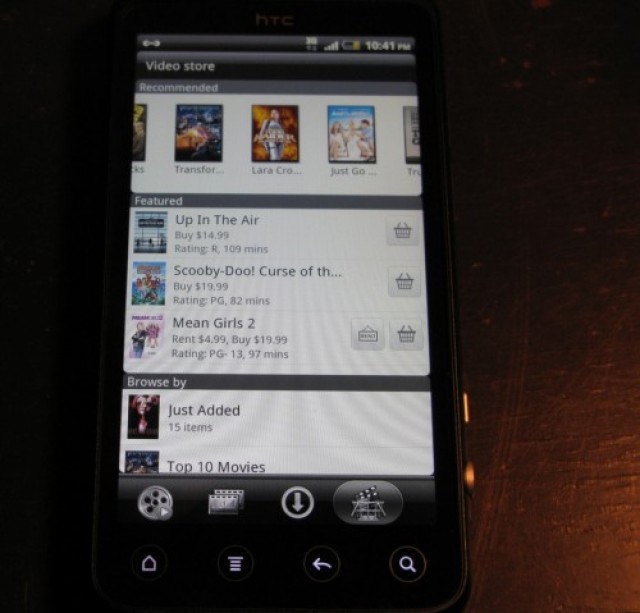
HTC has loaded the new Watch app in this build, which gives access to thousands of movies to rent and buy, along with a selection of TV shows for $2.49. The service is simple – you just need a credit card – and is a noble attempt to compete with iTunes. No other Android manufacturer has done as much as HTC to launch its own services that, while relying on the same underlying operating system as everyone else, exists independently from the framework.
The Reader app, which like Watch cannot be removed from the device, is powered by Kobo. Anyone who is already a Kobo customer can log in and download his or her books in a snap, and we found reading to be a superlative experience on the EVO’s bright and sharp screen.
In addition to Watch, HTC bundles apps to make Android as easy as possible to use out of the box. Some hardcore users may be turned off by the simplicity of the Contacts app, simply titled People, or the Messages app, which is about as bare as could be without sacrificing functionality, but there is a progressive consistency to the design of them. In many ways it reminds us of the recent renovation of Google’s web-based services after the introduction of Google+: lots of dark text on white background with restrained flair and limited flourish.

Performance
Whereas the EVO 3D excels in cross-UI fluidity it equally stumbles in synthetic benchmarks. While it can decode a 720p video stream without issue, and Flash videos play decently in the browser, we found results of benchmark suites like Quadrant, Smartbench 2011, Linkpack and Sunspider to be 20-30% below similar dual-core chipsets.
Scoring an average of 1950 in Quadrant from three iterations, we hoped it was a fluke. But when the Snapdragon MSM8260 chipset, which runs at a healthy 1.2Ghz, scored a medicore 52MFLOPS in Linkpack and an embarrassing 6545ms in the Sunspider Javascript test — some 40% slower than the OMAP-powered Optimus 3D — we were simply dumbfounded.
In real-world usage the differences were not apparent. As we said, the EVO 3D is not bottlenecked by games or apps alike, but merely cut down by the current crop of synthetic benchmarks, most of which will never be given a second thought to by the average consumer.

Battery Life
The 1730mAh battery inside the EVO3D is a blessing. The extra 200 or so mAh over the average Android battery goes a long way, though it’s likely in there because the 3D capabilities call for it. If you choose to stick to mostly 2D functionality, which will be the vast majority of user interaction, the device should last over a day of consistent medium-to-heavy usage.
Again, this is an Android phone and despite the relative efficiency of the processor you’re looking at half to three quarters of the expected battery life of the iPhone 4. We reiterate this if only to emphasize how far the platform still needs to come to reach the vastly superior power efficiency of the iOS platform. HTC does include a Task Manager to kill errant applications, but there is no reason why one should be forced to kill background apps just to eek out a few extra minutes of performance. Hopefully Ice Cream Sandwich will fix these underlying issues.
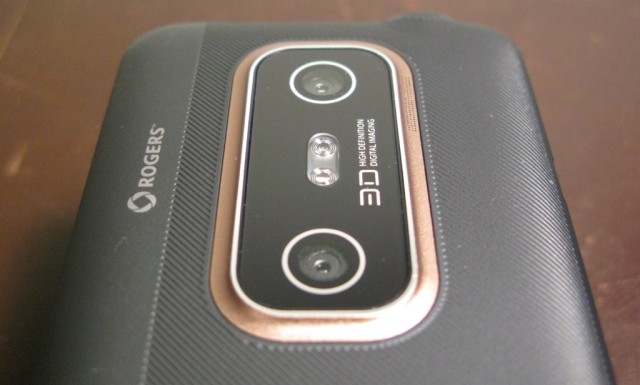
Cameras
The 5MP cameras on the back of the EVO work in unison to create 2MP 3D shots, or 720p 3D video. This is lower than the resolution of 3D stills obtained by the LG’s Optimus 3D, but we found the results to be consistently better, likely due to the quality of the sensors. 3D images can be saved in .jps or .mpo, though we didn’t notice any difference in quality between the two.
The effect, depending on the contrast between fore- and background objects, is quite intriguing, and we were often taken aback at how truly multidimensional the images were to the naked eye. Video, too, is impressive, and is captured at a healthy 720p, a notch above the rather-anaemic 2MP stills.
Two dimensional photos, captured at 5MP, are luscious and full-bodied, and we didn’t miss the 8MP sensor from the Sensation at all. Not only can you touch anywhere on the screen to auto-focus on a target, whether near or far, but it’s apparent that HTC extended their operating budget to figuring out just how to weight the dedicated camera shutter to feel just right. Employing a two-stage click, it is likely the best we’ve ever seen on a smartphone. The only problem we had was that occasionally the tip of our palm, when holding the device in place to snap a picture or video, would brush against, and subsequently activate, the capacitive home button, triggering the ‘Most Recent Apps’ multitasking menu and interrupting our shot.
The 1.3MP front-facing camera does a great job capturing video over 3G or WiFi, and we are happy to say that Google Talk supports video calling in this build.
One of the nicer aspects about the EVO 3D is that, with an optional $40 adapter, the USB port can be converted into a mini HDMI out on, which can be mirrored to a compatible TV to watch your photos or videos, in either two- or three dimensions. Or, if that isn’t up your alley, the EVO 3D supports DLNA sharing to stream pictures and video to your 3D-enabled television.

Rogers Additions
With every Android device released by a carrier there are a number of expected ‘additions’, also known as bloatware. Luckily for us, there is a minimal amount of ‘bloat’ in these wares.
Bundled is RODO, the Rogers on Demand Online service you get free with a subscription to any Rogers product. While there is a paucity of quality content, the existence of the service itself, along with HTC’s Watch, brings streaming media to Android in a way no other manufacturer has been able to do. Unlike Bell’s TV & Radio app, which requires a $5 per month subscription to certain packages, RODO is free, the way it should be.
Also bundled is a WiFi Calling app. Anyone familiar with UMA on the BlackBerry Curve 8900 will appreciate the inclusion of this app, though the service is not free. For $10/month, you can use a WiFi connection to make calls where there may not be a cellular signal, or merely to enhance call quality in general.
The rest are pretty unobtrusive: MyAccount, Ringbacks/Ringtones (which area ctually just web portals for ringtones), Shop, and urMusic. A 3D version of Gameloft’s Spiderman is also included, though we couldn’t get it to play due to the initial data download continually failing.

Network Performance and Call Quality
Rogers is marketing the EVO 3D as a 4G device, and, true to its word the radio inside does support download speeds of up to 14.4Mbps. While not the fastest we’ve seen, the EVO performed its network duties with aplomb, averaging over 3.5Mbps in the download and just under 2Mbps in the upload, with a lovely low ping time of 86ms.
Call quality was excellent, as there is a second microphone for noise cancellation near the speaker grill at the top of the phone. The speaker, for which the sound is emitted by an unobtrusive grill on the side of the device, is pretty loud and clear. It won’t win any awards for dynamic range, but for the odd song or conference call it does a great job.

Hackability
What was once a pipe dream is now a reality. HTC has officially announced the unlocking of its devices’ bootloaders via a handy web portal, with which the Rogers EVO 3D will soon be compatible (the Sprint version already is). Independently, a group called Revolutionary has released a tool that does just that: turns off the security on the device, which allows for custom ROMs, kernels and recovery images. If this is all gibberish to you, don’t worry, but for those in the know, or who want to be, it makes the EVO 3D a very flexible and powerful toy. Already the community is taking advantage of its power, stripping away the bloat and leaving a mean dual-core Android machine.
Conclusions
Is the EVO 3D just a Sensation with two cameras? It would appear the two devices were designed by completely different teams, with opposite aesthetic approaches. Whereas the Bell device is lean and metallic, the Rogers EVO 3D puts on some muscle, and gains some impressive abilities as a result. Many will dismiss its 3D capabilities as gimmickry, but see it before dismissing it: the results, and your affection for them, may surprise you.
More than that, and something we haven’t touched on, is that the EVO is Rogers best smartphone at the moment. It performs more fluidly than the Optimus 3D, beats the Xperia arc in battery life and screen quality, runs circles around the Xperia Play in gaming performance (though we miss the dedicated controls), and uses the Infuse as its personal chew toy. While each of those devices may do one or two things better, the EVO 3D does everything really well, running on the tried-and-tested Sense UI.
It also shows that Rogers and HTC have kissed and made up after the 911 calling debacle with the Magic and Dream. Remember, Rogers was the first Canadian carrier to release an Android device in early 2009, and since then all other HTC devices have gone to either Bell or Telus, leaving many to wonder if the relationship was damaged beyond repair.
The EVO 3D is $549.99 outright or $149.99 on a 3-year term through Rogers, but if you’re looking to save a bit of money both Future Shop and Best Buy have this on sale for $74.99.
Rating: 8.5/10
Pros:
– Beautiful 4.3″ display is vibrant and sharp with good colour saturation
– Excellent build quality
– Dedicated camera button is one of the best in the business
– Good overall performance
– Camera quality is decent in both 2D and 3D; video noteworthy in 2D
– Network speeds improved over traditional “3G” phones
– Excellent battery life (for an Android)
– HDMI-out via optional MHL adapter
– Thriving modding/hacking community with HTC-endorsed bootloader unlock tool
Cons:
– Poor viewing angles, especially for 3D content
– Low 3D still photo resolution
– Quite thick and bulky for a flagship device
– Low synthetic benchmark scores compared to other dual-core solutions

